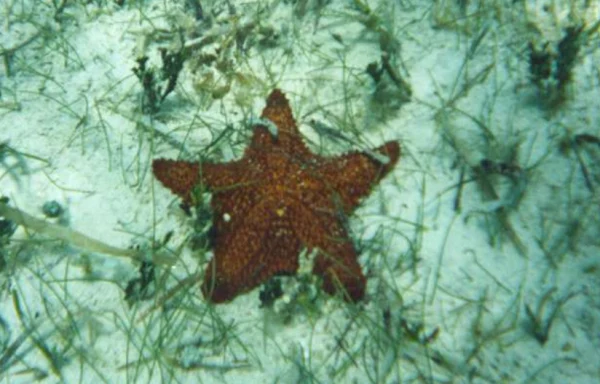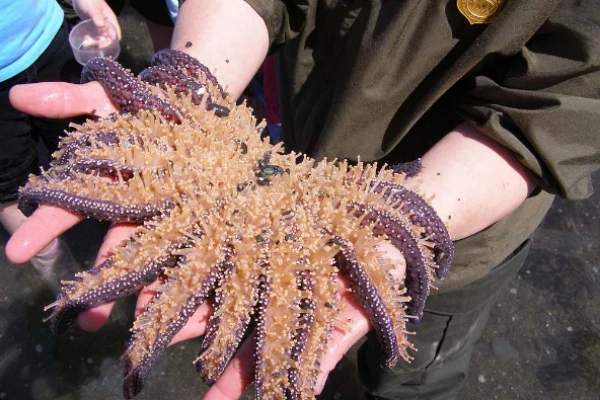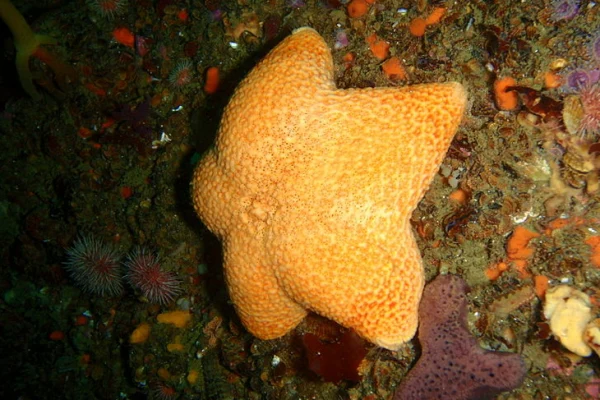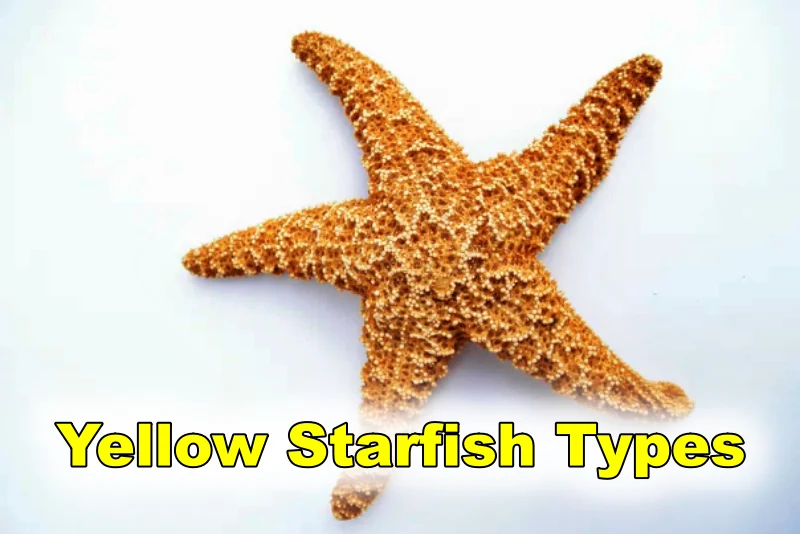On the surface of the earth and under the waters of the ocean, there is a world of beautiful creatures. The ocean shows us how beautiful a creature can be. And tell us who has the real power of creation—”nature.” Nature made us and all the creatures, whether living or not.
There are many more colors in the world than you think, and more than we humans have named. and all those colors are so beautiful that no one can explain them. In our day-to-day lives, we commonly find hundreds of colors around us, but whenever we want to express our happiness, we choose yellow.
We symbolize yellow as the color of joy and happiness. And today we are going to talk about a creature who lives in the ocean, looks like it is coming from the sky, and has a yellow color. I think you get it. Yes, that’s none other than yellow starfish, or you can say yellow sea star.
So, here are a few yellow starfish species we are going to talk about.
Types of Yellow Starfish
1. West Indian Sea star

| Scientific name | Oreaster reticulatus |
| Location | Western Central Atlantic, Bahamas, Cape Frio, Cape Hatteras, the Caribbean Sea, Florida, the Gulf of Mexico, Guyanas and Yucatán |
| Identification | Blunt spines on hard upper surface |
West Indian sea star is commonly known as red cushion sea star. This species of sea star can grow up to 50 cm. Taking color into consideration this starfish ranges from red, yellow, brown, and orange when they become an adult.
Talking about the juveniles, they had mottled making on a greenish-brown background. Usually, these species have five thick arms and look broad. Its upper hard surface has spines that are blunt.
2. Sunflower sea star

| Scientific name | Pycnopodia helianthoides |
| Location | Southern California, Puget Sound, British Columbia, northern California, and Alaska |
| Identification | Bulky body with thick limbs |
Like its name sunflower, this starfish has many limbs and is big in size. Looking at the size, this sea star’s arm can grow up to a meter.
A full-grown adult has 16 to 24 thick limbs. This jumbo-size starfish has variations in colors with a velvet and soft-looking texture.
They can be seen in various colors like red yellow- red, orange-brown, purple, and many more. A normal sunflower starfish has 5 kg of weight.
3. Chocolate chip starfish
| Scientific name | Protoreaster nodosus |
| Location | Indonesia, Madagascar, Australia, Philippines, and Southern Japan |
| Identification | Rows of knob-like protrusion |
Chocolate Chip Starfish have a star-shaped, calcified body with penta-radial symmetry. This yellow starfish features a central disk with stout arms. In fact, the central disk can reach a diameter of 12 cm. Also, it has been seen that the arms measure about 14 cm.
On the whole, the entire body can reach up to 40 cm. Along with this, this starfish has short and thick arms.
So you know what makes it more identifiable among all the starfish, and what gives it the name of the chocolate chip starfish? That’s only because it has a row of pointy tubercles or knob-like protrusions on each arm.
These knobs look very similar to chocolate chips. Further, on the lower surface, they had pale purple or transparent pink tube feet that were arranged in rows on each arm.
Do you know The chocolate chip sea star can be varied in terms of size, color, and pattern? You can find different color combinations, such as yellow, brown, red, and many more, with common darker or black knobs.
4. Cushion star

| Scientific name | Culcita novaeguineae |
| Location | Madagascar, Seychelles, Philippines, New Guinea, Australia, and Hawaii |
| Identification | Shorter arms like inflated disc |
This pentagonal pincushion-shaped sea star has the same name as its look, which is a cushion sea star. But in the world of science, this species is named Culcita novaeguineae.
If you see this sea star, you might think it is a cushion for your living area, but it is not. This starfish seems like a cushion because of its short arms and infiltrated appearance.
As they grow, the inter-arm areas fill in and expand, while the arms become shorter relative to the inflated disc.
Along with this, looking at their size and color, they can be varied. But mostly, this sea star can grow up to 30 cm. Considering their color, as we said above, they have variations; you can find them in yellow, red, green, fawn, orange, and many more colors.
Further, their armored body wall is made up of calcareous ossicles, which are supported by pillars. Besides, they had a body cavity filled with water.
5. Icon sea star
| Scientific name | Iconaster longimanus |
| Location | southeastern Arabia, the Philippines, Singapore, Malaysia, the South China Sea, Indonesia, and Australia |
| Identification | Star shape at disc |
Have you ever seen a star in a star? The answer may be no, but here is a species of starfish that has a sharp shape at the center of its disk. The Iconaster longimanus is a species of starfish that has a star shape on its disc.
Do you know this starfish, also known as the icon star or double star?
You can find this starfish species in the Indo-Pacific Ocean. It has five thin and flattened arms. Besides, this species can grow to 30 cm, and its central disc covers 10 cm of its total diameter.
Considering its color, you may find this species uncommonly yellow with an orange-brown disk and black stripes on the arms. The marginal row of large plates resembles mosaic tiles.
6. Invasive brittle star
| Scientific name | Ophiothela mirabilis |
| Location | Pacific Ocean, Caribbean, and southwestern Atlantic |
| Identification | Translucent and thorny spines |
There are many brittle star species, and among all those, one is Ophiothela mirabilis. This species of starfish has six irregular-shaped arms.
You can find this species in variable colors like orange, yellow, blue, and many more. Most of these sea stars have bright colors.
Along with this, all arms have translucent, thorny spines, and the jaws contain tooth papillae on the apex but not on the sides. Also, the dorsal surface of the disc is covered with spines and thorny towers.
7. Bat star
| Scientific name | Patiria miniata |
| Location | Sitka, Alaska, Baja California, Pacific Ocean, and Monterey Bay |
| Identification | Wide central disk with stubby arms |
Patiria miniata is the next species we are going to talk about. This species of starfish is familiar to the world through its names like bat star, webbed star, and broad-disk star.
The bat star has five arms, which can sometimes be nine. Along with this, the central disk is wider than their stubby arms.
You can find it in various colors, including green, purple, red, orange, yellow, and brown. Besides, they look like bats; that’s why they were named bat stars.
8. Common Sunstar
| Scientific name | Crossaster papposus |
| Location | Atlantic and Pacific Oceans |
| Identification | madreporite plate |
You can easily find this star in the Atlantic and Pacific Oceans. Generally, they had a red color on the top and various concentric bands that varied in color from each other.
They have been seen in colors like pink, yellow, dark red, and white. Along with this, the common sunstar has brushlike spines on top and a thick central disk.
Also, it has a bare mouth and a central disc with raised ridges. Talking about its length, this sea star has a diameter of 30 cm. You will see the madreporite plate as its prominent feature.
9. Japanese common starfish
| Scientific name | Asterias amurensis |
| Location | China, Korea, Russia, Japan, Alaska, the Aleutian Islands, and Canada |
| Identification | jagged-edged spines joining up at the mouth in a fan-like shape |
You might be aware of this starfish species. But did you know it also has a yellow color? Asterias amurensis is also known as the Northern Pacific seastar and the Japanese common starfish.
Generally, these species can grow up to 30 cm, and their arms are approximately 16.1 cm. Along with it, they have five arms and a small disc.
Besides, the arms are unevenly covered with small, jagged-edged spines, joining up at the mouth in a fan-like shape.
Talking about the colors, they have a fully yellow underside body, but the colors of the upper side can be varied, like orange, yellow, red, and purple.
10. Eleven-armed sea star
| Scientific name | Coscinasterias calamaria |
| Location | Australia and New Zealand |
| Identification | rows of pincer-like pedicellariae on its upper |
Coscinasterias calamaria is commonly known as the eleven-armed sea star. You can find this starfish in southern Australia and New Zealand. The starfish’s prickly appearance is due to its rows of pincer-like pedicellariae on its upper and lower surfaces.
Also, they can have any number of arms, with eleven being the most common. Do you know what the length of this starfish is? This starfish can grow up to 30 centimeters in diameter.
11. Brooding cushion star
| Scientific name | Pteraster capensis |
| Location | South Africa |
| Identification | small sized starfish |
Pteraster capensis, a native of South Africa, is known for its unique behavior of keeping its brood of eggs between its outer and inner skins. This keeps the eggs in moving water, providing them with oxygen for survival.
The layer between its skins is constantly filled with both eggs and water, giving it a bloated appearance. With a diameter of just 35 millimeters, it is one of the smallest starfish in the world.
12. Common Brittle star
| Scientific name | Ophiothrix fragilis |
| Location | West Europe and South Africa |
| Identification | spines all over the body |
Ophiothrix fragilis is a species of brittle star in the order Ophiurida, found along the coasts of western Europe and South Africa. Its coloration varies from violet, purple, or red to yellowish or pale grey, often spotted with red. The arms are white or grey with pink bands, and the central disc is about one centimetre in diameter.
Do you know the five arms are about five times as long, with five pairs of triangular plates forming a heart-shaped pattern? The slender tapering arms are distinct from the disc and covered with overlapping scales. Furthermore, the dorsal arm plates are naked and have a longitudinal keel. Each arm segment bears seven glassy, toothed spines. The arms are fragile and easily shed.
13. Biscuit star
https://in.pinterest.com/pin/903394006477373688/
| Scientific name | Tosia australis |
| Location | Sydney, Victoria, South Australia, Western Australia, and Tasmania |
| Identification | Small plates at each sides |
The Biscuit Sea Star is about the size of a large biscuit and lives on intertidal rocky shores and coastal waters to a depth of 40 meters. It is characterized by its distinctive bright orange, yellow, and red appearance, and is found in Sydney, Victoria, South Australia, Western Australia, and Tasmania.
14. Doughboy starfish
| Scientific name | Choriaster granulatus |
| Location | East Africa, Indo-Pacific region, Great Barrier Reef, Red Sea, Fiji, and Papua New Guinea |
| Identification | distinct pattern at whole body |
Choriaster granulatus, also known as the granulated sea star, is a large sea star in the Oreasteridae family. It has a convex body and five short arms with rounded tips, making it appear “phallic”. Its maximum radius is about 27 centimetres and is typically pale pink with brown papillae radiating out from the center. It is harmless to humans and can be a variety of colors, including grey, yellow, and red.
15. Antarctic sun starfish
| Scientific name | Labidiaster annulatus |
| Location | Antarctic, Atlantic, South Georgia and South sandwich Island |
| Identification | 50 long and narrow arms |
The Antarctic Sun starfish, also known as Labidiaster annulatus, is a large, predatory marine species with 50 long and narrow arms that resemble the Sun’s rays.
With a diameter of up to 60 centimeters, it primarily lives in Antarctic waters but also exists in the South Atlantic, including South Georgia and the South Sandwich Islands. The starfish is known for its predatory behavior, often climbing on rocks and spreading its arms into the water. Due to its remote habitat, the Antarctic Sun starfish remains largely unknown to marine biology.
Conclusion:
Coming to the end, here we see some of the beautiful yellow-colored sea stars or starfish. Like other sea creatures, these starfish are also a beauty of nature.
Their shapes and colors, or tones, are blessed with an attractiveness that no one can deny. These cute and amazing starfish are one of the creatures we want to make you aware of. For more like this, stay tuned to HowItSee.
Reference:
- https://en.m.wikipedia.org/wiki/Oreaster_reticulatus
- https://en.wikipedia.org/wiki/Sunflower_sea_star
- https://en.wikipedia.org/wiki/Culcita_novaeguineae
- https://en.wikipedia.org/wiki/Iconaster_longimanus
- https://en.wikipedia.org/wiki/Coscinasterias_calamaria
- https://en.wikipedia.org/wiki/Ophiothela_mirabilis
- https://en.wikipedia.org/wiki/Patiria_miniata
- https://en.wikipedia.org/wiki/Common_sunsta
- rhttps://en.wikipedia.org/wiki/Asterias_amurensis
Also Read:

As a content writer, I like to write about different niches. I have a curiosity about nature and animals. And like to learn about them. Through my writing, I like to share my experience and knowledge with you. I hope you are enjoying it too.

